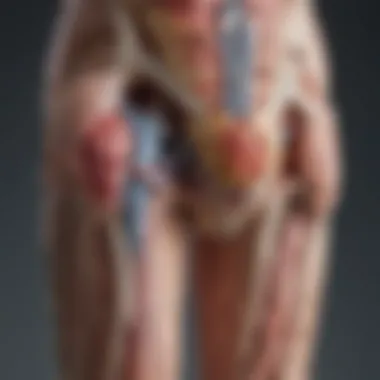Understanding Rheumatoid Osteoarthritis: A Comprehensive Study


Intro
Rheumatoid osteoarthritis is a term that stirs curiousity among healthcare professionals and patients alike. At first glance, it appears as a straightforward amalgamation of rheumatoid arthritis and osteoarthritis. However, it is key to understand that this hybrid condition is more intricate than it seems. The intersection of these two forms of arthritis presents a unique clinical challenge, one that demands in-depth knowledge and comprehensive strategies of management.
The coexistence of rheumatoid arthritis, characterized by systemic autoimmune inflammation, and osteoarthritis, which stems from degenerative joint changes, can create a perfect storm in a patient's body. As a practicing clinician or researcher, recognizing the nuances and underlying mechanisms linking these conditions is crucial in tailoring effective treatment plans.
To further explore this topic, we will delve into various aspects such as the pathophysiology, clinical manifestations, treatment options, and patient care strategies surrounding rheumatoid osteoarthritis. It is essential, therefore, to elucidate how this complex condition can significantly impact both the quality of life and functional capacity of afflicted individuals.
In this article, we aim to provide not just a coherent narrative but a thorough examination of the current literature, evidence-based practices, and emerging research in the realm of rheumatoid osteoarthritis. The interplay between these two distinct yet interrelated conditions will serve as a focal point for our investigation.
This journey into the complexities of rheumatoid osteoarthritis is not just for those already familiar with the field; even students, newcomers, and patients interested in comprehending their health issues will find valuable insights and guidance.
As we unfold the myriad layers of this affliction, we will underscore the relevance of understanding and addressing rheumatoid osteoarthritis in today’s medical landscape.
Intro to Rheumatoid Osteoarthritis
Rheumatoid osteoarthritis stands at a unique crossroads in the realm of musculoskeletal disorders, merging elements from two distinct conditions: rheumatoid arthritis and osteoarthritis. This combination isn't merely a theoretical construct; it carries significant implications for the patients who face this dual threat. More than just a label, understanding the nuances of this condition is crucial for professionals in healthcare and academia alike. The exploration of this topic serves multiple purposes.
Firstly, it provides clarity on how symptoms manifest and overlap. This aspect is vital for accurate diagnosis and effective treatment plans. Without a comprehensive understanding of the intricacies of these diseases, healthcare providers might misdiagnose or overlook crucial symptoms that could alter patient care.
Secondly, recognizing the epidemiological backdrop allows professionals to better grasp how prevalent this condition is in various demographics. For example, studies might show a rising incidence among women post-menopause or link increased obesity rates to a higher prevalence. This can drive public health policies and targeted research in preventive measures.
Lastly, the implications for therapeutic strategies and management can't be understated. Since rheumatoid osteoarthritis combines the inflammatory nature of rheumatoid arthritis with the degenerative aspects of osteoarthritis, practitioners must carefully design treatment protocols that address both conditions. Insight into this topic leads to tailored management strategies, enhancing patient outcomes.
In summary, delving into rheumatoid osteoarthritis isn't just about academic curiosity; it's about improving the lives of those affected and providing professionals with the tools they need for effective care.
Defining Rheumatoid Osteoarthritis
Rheumatoid osteoarthritis is primarily characterized by the blend of features that stem from both rheumatoid arthritis and osteoarthritis. On one hand, rheumatoid arthritis is an autoimmune disorder known for its inflammatory processes and systemic symptoms, such as fatigue and morning stiffness. On the other hand, osteoarthritis is a degenerative joint disease featuring wear and tear on the cartilage, leading to pain and reduced mobility.
The merging of these two conditions results in a complex clinical presentation. Patients may exhibit both the aggressive inflammation typical of rheumatoid arthritis while simultaneously showing wear-related damage in their joints, a hallmark of osteoarthritis. Hence, defining rheumatoid osteoarthritis requires an appreciation of these dual characteristics.
Rheumatoid osteoarthritis can be further viewed as a spectrum. Some patients may display more prominent features of one condition over the other, making this illness appear differently from one person to another. As healthcare providers grapple with the realities of this hybrid condition, they must remain ever vigilant in their approach to treatment, diagnostic criteria, and patient education.
Epidemiological Overview
The epidemiology of rheumatoid osteoarthritis illustrates a multifaceted scenario requiring careful examination to capture its extent and impact on various populations. Statistically, it has been shown that certain demographics, particularly older adults, are at a heightened risk. In fact, some studies indicate that nearly one in five adults over the age of sixty grapples with some form of arthritis, with a significant portion falling into this rheumatoid osteoarthritis category.
Additionally, gender differences are noteworthy. Women tend to experience inflammatory arthritides at higher rates than men. This trend further complicates the epidemiological landscape, as the likelihood of coexisting osteoarthritis compounds the burden on female patients.
Here are some key points regarding the epidemiological aspects of rheumatoid osteoarthritis:
- Age-related incidence: Risk increases significantly with advancing age.
- Gender disparities: Women are disproportionately affected compared to men.
- Comorbid conditions: Increased rates of obesity and other metabolic syndromes further heighten the disease's impact.
In light of these facts, understanding the epidemiological overview of rheumatoid osteoarthritis is paramount for shaping healthcare approaches and facilitating further research aimed at tackling these issues head-on.
Pathophysiological Mechanisms
Understanding the pathophysiological mechanisms of rheumatoid osteoarthritis is critical for both diagnosis and treatment. This condition combines the chronic inflammation seen in rheumatoid arthritis with the degenerative aspects of osteoarthritis. Identifying these interconnected pathways can lead to more effective management strategies, helping to alleviate symptoms and improve quality of life for those affected.
Inflammatory Responses
The inflammatory response in rheumatoid osteoarthritis is often a double-edged sword. On one hand, it serves as a defense mechanism, targeting harmful stimuli. However, when inflammation becomes chronic, it inflicts more harm than good. Cytokines, small proteins important in cell signaling, play a significant role in this inflammation. They send signals that initiate the inflammation process, which can ultimately cause joint swelling, pain, and stiffness.
In this context, diseases like rheumatoid arthritis lead to an exaggerated inflammatory response, perpetuating a cycle of damage. The key players in this process include:
- Tumor Necrosis Factor-alpha (TNF-alpha)
- Interleukins (such as IL-1 and IL-6)
- Adhesion molecules
These elements not only elevate the inflammatory process but also pave the way for destructive changes seen in joint tissue. It’s important to understand that targeting these responses through pharmacological interventions can reduce joint damage and enhance the quality of life.
"Effective management of inflammation could potentially halt or even reverse the progression of joint damage."
Joint Degradation Processes


Joint degradation processes are a critical area of concern. In rheumatoid osteoarthritis, the cartilage within joints suffers wear and tear but also faces the wrath of immune-mediated attacks. This degradation is a cumulative outcome of both mechanical stress and inflammatory insult.
Common mechanisms include:
- Cartilage matrix degradation: This occurs primarily due to the activity of matrix metalloproteinases (MMPs), enzymes that break down cartilage, leading to joint dysfunction.
- Subchondral bone changes: The underlying bone can undergo changes that affect the stability and functionality of the joint.
- Synovial inflammation: This aspect amplifies pain and further leads to cartilage loss.
All these factors contribute to a vicious cycle that further exacerbates the patient's condition, making it crucial to find interventions that can slow down or prevent these processes.
Role of Autoimmunity
Autoimmunity is a cornerstone of rheumatoid osteoarthritis, differentiating it from standard osteoarthritis. In a typical scenario, the body’s immune system identifies its own tissues as targets, leading to an all-out assault on joint structures. This misfiring immune response can trigger significant damage.
Key elements in this relationship consist of:
- Antibody production: Autoantibodies like rheumatoid factor (RF) and anti-citrullinated protein antibodies (ACPA) are often present, serving as biomarkers for the disease.
- Lymphocyte activation: T-cells and B-cells become activated, contributing to chronic inflammation.
- Synovial cell activation: The synovium, or the lining of the joint capsule, becomes inflamed and can thicken, leading to further joint destruction.
Recognizing the role of autoimmunity in this context holds considerable significance for developing targeted therapies, helping to modify the disease and ease the burden on patients.
Clinical Presentation
The clinical presentation of rheumatoid osteoarthritis holds significant importance because it serves as the entry point for diagnosis and subsequent management of this complex condition. Recognizing the overlapping symptoms and signs is vital for differentiating between rheumatoid arthritis and osteoarthritis, which can lead to more targeted therapeutic strategies. The visible manifestations of the disease, alongside patient-reported symptoms, provide essential clues that clinicians must piece together like a puzzle.
Symptoms and Signs
Rheumatoid osteoarthritis can present a mixed bag of symptoms, which often create a challenge for both patients and healthcare professionals. Patients may experience joint pain, stiffness, and swelling that can fluctuate in intensity. This fluctuation is emblematic of the dual nature of this condition. Here are some common symptoms:
- Morning Stiffness: Often lingering for more than 30 minutes, this stiffness signals the inflammatory component of rheumatoid arthritis rather than osteoarthritis alone.
- Joint Redness and Warmth: Patients might observe redness and feel warmth around affected joints, a result of inflammatory processes.
- Decreased Range of Motion: As the day progresses, patients may experience limited joint mobility, affecting daily activities and quality of life.
- Fatigue and Malaise: This systemic symptom reflects the body's ongoing fight against inflammation
It’s also worth noting that these symptoms can differ in severity from one individual to another, contributing further to diagnostic complexity.
"Understanding the nuances of symptoms is not just clinical; it’s personal. Each individual’s experience shapes their treatment and care approach."
Diagnostic Criteria
Establishing diagnostic criteria for rheumatoid osteoarthritis is paramount in ensuring accurate treatment plans. Clinicians often utilize a blend of clinical history, physical examination findings, and laboratory tests to identify the presence of this hybrid condition.
Key elements in the diagnostic framework include:
- Clinical History: A thorough patient history that focuses on symptom onset, duration, and specifics can illuminate the disease’s trajectory.
- Physical Examination: Assessing joint functionality and noting any observable signs like swelling, warmth, or limitations is crucial.
- Laboratory Testing: Blood tests for specific markers like Rheumatoid Factor (RF) or Anti-Citrullinated Protein Antibodies (ACPA) can support the diagnosis, albeit not exclusively.
- Imaging Techniques: Radiographic evaluations may help reveal joint inflammation, erosion, or other changes indicating disease progression.
The integration of these components enables healthcare providers to render an informed diagnosis that guides treatment pathways effectively. This comprehensive approach not only consults empirical data but also weighs individual patient experiences, which can be just as telling.
Understanding clinical presentation, including the spectrum of symptoms and the rigorous diagnostic criteria, is essential for devising a balanced care plan that promotes positive patient outcomes.
Differentiating Between Conditions
Understanding the nuances between rheumatoid arthritis (RA) and osteoarthritis (OA) is more than just an academic exercise; it is vital for effective management and treatment of patients suffering from rheumatoid osteoarthritis. This hybrid condition combines features of both forms of arthritis, complicating the clinical landscape. The ability to differentiate between these conditions can significantly influence patient outcomes, treatment approaches, and ultimately quality of life.
Rheumatoid Arthritis vs. Osteoarthritis
While both rheumatoid arthritis and osteoarthritis affect the joints, their origins, pathophysiology, and clinical manifestations starkly differ.
Rheumatoid Arthritis
- Autoimmune Nature: RA is primarily an autoimmune disorder where the body's immune system mistakenly attacks the synovium, leading to inflammation. This is coupled with systemic symptoms such as fatigue and malaise.
- Typical Joint Involvement: It often presents bilaterally and symmetrically, affecting joints like the hands, wrists, and knees.
- Symptoms: Patients may experience morning stiffness that lasts more than an hour and joint swelling, which can lead to deformities if not managed effectively.
Osteoarthritis
- Degenerative Process: OA is primarily due to wear and tear of cartilage over time. It does not typically involve the immune system directly, making the processes of degeneration and repair key components.
- Asymmetrical Joint Involvement: OA can affect any joint but is more common in weight-bearing joints such as the knees, hips, and hands. It tends to present asymmetrically.
- Symptoms: Morning stiffness usually lasts for less than 30 minutes and is often relieved with activity, unlike RA.
To conclude, while the two disorders share symptoms like joint pain, their underlying mechanisms differ fundamentally, which should guide therapeutic approaches.
Overlap Syndrome


Overlap syndrome, where a patient exhibits features of both RA and OA, presents a real challenge for both diagnosis and treatment. This occurs when the inflammatory processes of rheumatoid arthritis coalesce with the degenerative pathologies of osteoarthritis.
"Identifying overlap syndrome is critical; misdiagnosis can lead to inappropriate treatments that may aggravate the condition."
Key Considerations in Overlap Syndrome:
- Symptoms: Patients may reflect traits of both diseases—morning stiffness and swelling from RA, combined with the joint pain experienced in OA.
- Diagnosis: This dual presentation complicates diagnosis. Practitioners must consider serological tests, imaging, and patient history carefully.
- Treatment Implications: Treatment plans may need to be hybridized, incorporating anti-inflammatory agents alongside pain management strategies that are typically used in OA. An individualized approach is essential to cater to the patient's specific symptoms and progression of the disease.
In summary, appreciating the distinctions between RA and OA, as well as recognizing overlap syndrome, can lead to more effective therapies tailored for patients experiencing rheumatoid osteoarthritis. It also enhances communication among healthcare professionals, leading to better management strategies and improved patient care.
Diagnostic Approaches
The significance of diagnostic approaches in understanding rheumatoid osteoarthritis cannot be overstated. Correct diagnosis lays the foundation for effective treatment and management of the condition, which can be quite challenging given its typical overlap with other arthritis forms. Through various diagnostic methods, healthcare professionals can elucidate the complexities underlying the symptoms, leading to more tailored patient care.
Imaging Techniques
Imaging techniques are essential for visualizing the anatomical and structural changes in joints affected by rheumatoid osteoarthritis. Among the most utilized methods are X-rays, magnetic resonance imaging (MRI), and ultrasound. Each of these techniques offers unique insights:
- X-rays provide a clear image of bone structure and can show joint space narrowing, erosions, and deformities. They are standard in diagnosing arthritis but often miss early soft tissue changes.
- MRI excels at revealing soft tissue conditions, such as inflammation of the synovial membrane and cartilage damage. It's particularly useful in early detection, where subtle changes might indicate the onset of rheumatoid osteoarthritis.
- Ultrasound is gaining traction as it allows evaluate synovial fluid and helps identify inflammatory changes in real-time, giving a dynamic perspective that X-rays and MRIs cannot.
Incorporating these imaging methods forms a cornerstone in diagnosing rheumatoid osteoarthritis. Each technique's specificity and sensitivity vary, creating a comprehensive picture through complementary visuals that can guide treatment strategies effectively.
Laboratory Tests
Laboratory tests play a critical role in diagnosing rheumatoid osteoarthritis and differentiating it from other conditions. Several biomarkers can be indicative:
- Rheumatoid Factor (RF) is a specific antibody found in many individuals with rheumatoid arthritis but could present in osteoarthritis, complicating the picture.
- Anti-Citrullinated Protein Antibodies (ACPA) are highly specific to rheumatoid arthritis and can aid in identifying those patients who may progress in their disease.
- C-reactive protein (CRP) and Erythrocyte Sedimentation Rate (ESR) are non-specific markers indicating inflammation but lacking specificity for rheumatoid osteoarthritis alone.
Additionally, synovial fluid analysis can provide valuable information. The presence of inflammatory cells may suggest an autoimmune component, emphasizing the mixed nature of the disease. Understanding these tests' nuances is essential for interpreting results, as false positives or negatives can alter management strategies dramatically.
Clinical Assessments
Clinical assessments involve systematically evaluating the patient's symptoms and physical examination findings. This process is invaluable for understanding the impact of rheumatoid osteoarthritis on daily living and informing treatment decisions. Key aspects include:
- Patient History: Gathering comprehensive medical history helps pinpoint symptom onset, duration, and associated features. The subjective nature of pain and functional limitation can strongly influence patient response to treatment.
- Physical Examination: This involves evaluating joint swelling, tenderness, and range of motion, which provides critical clues about disease activity and function. Observing how patients interact with their environment can often reveal how significantly their quality of life is affected.
- Functional Assessments: Tools such as Health Assessment Questionnaires can gauge daily functioning. By identifying how rheumatoid osteoarthritis hampers mobility and quality of life, clinicians can customize intervention strategies more effectively.
Therapeutic Strategies
When addressing rheumatoid osteoarthritis, the selection of appropriate therapeutic strategies becomes a pivotal component in enhancing patient outcomes. This approach not only encompasses pharmacological options but also emphasizes non-pharmacological interventions, which can significantly influence the overall management of the condition. The importance of identifying tailored therapeutic strategies lies in their ability to address the unique challenges posed by this complex condition, ultimately improving quality of life for those affected.
Pharmacological Treatments
In the realm of pharmacological treatments, several classes of medications are available, each designed to tackle different facets of rheumatoid osteoarthritis. Nonsteroidal anti-inflammatory drugs (NSAIDs) are often the first line of defense, as they mitigate pain and inflammation. Options such as ibuprofen or naproxen can provide swift relief for many patients. However, care must be exercised due to potential long-term effects on gastrointestinal health and cardiovascular risks.
Another category of medications involves disease-modifying antirheumatic drugs (DMARDs), like methotrexate and sulfasalazine. These agents aim not merely to relieve symptoms but to alter the disease’s trajectory, preventing further joint damage. Clearly, the role of DMARDs is significant, particularly in early-stage diagnosis where proactive measures can yield healthier joint longevity.
In certain cases, corticosteroids may be prescribed to manage flares of intense inflammation. Their rapid anti-inflammatory effects can be a boon in acute scenarios, yet physicians must be wary of their protracted use, as it can lead to side effects ranging from osteoporosis to weight gain. Thus, a balanced approach is imperative here, maximizing benefits while minimizing adverse outcomes.
Non-Pharmacological Interventions
When it comes to non-pharmacological interventions, these strategies often complement pharmacological treatments and can play a crucial role in the holistic management of rheumatoid osteoarthritis.
- Physical Therapy: Tailored exercise regimens led by physical therapists can greatly enhance joint functionality. These exercises strengthen the muscles surrounding the joints, improving stability and mobility. Water-based therapy, in particular, reduces the strain on joints while providing resistance, making it an excellent alternative for many patients.
- Occupational Therapy: This branch of therapy focuses on improving patients’ ability to perform daily activities. Occupational therapists can suggest adaptive tools and techniques, allowing patients to engage more fully in life, despite their limitations.
- Nutritional Management: Diet can influence inflammation levels in various ways. Incorporating omega-3 fatty acids found in fish, along with a range of colorful fruits and vegetables, can combat oxidative stress, potentially alleviating symptoms accentuated by unhealthy eating habits.
- Mind-Body Approaches: Exploring stress-relieving techniques like yoga and meditation is becoming increasingly recognized in rheumatology. These practices not only enhance mental health but also contribute to the overall perception of pain.
"The intersection of mind and body can unlock new pathways to resilience in managing chronic pain, including that from rheumatoid osteoarthritis."
Thus, understanding and implementing a varied set of therapeutic strategies not only provide symptom relief but also promote a proactive stance against further deterioration of the joint condition. This multi-faceted approach requires cooperation among healthcare professionals to craft individualized treatment plans, ensuring that each patient receives a comprehensive, patient-centered care experience.
Current Research and Developments
Understanding rheumatoid osteoarthritis is as challenging as it is important. The combination of rheumatoid arthritis (RA) and osteoarthritis (OA) presents a unique set of problems, and staying abreast of current research can make a world of difference in treatment approaches. As more studies unfold, it becomes clearer how to navigate the complexities of this hybrid disease. Recent breakthroughs in both emerging therapies and pioneering research directions highlight the evolving landscape of managing this condition.
Emerging Therapies


Therapies are always evolving, with recent studies bringing forth exciting possibilities. Among the emerging therapies for rheumatoid osteoarthritis, biologics have captured significant attention. These medications, derived from living organisms, can target specific pathways involved in the inflammatory process. For instance, interleukin inhibitors, such as tocilizumab, have shown promise in reducing joint inflammation.
Researchers are also exploring platelet-rich plasma (PRP). This treatment involves injecting a concentration of platelets from the patient's own blood into the affected joint, potentially promoting healing and reducing pain.
Meanwhile, stem cell therapy is making waves, offering the potential to regenerate damaged cartilage. Stem cell injections involve using cells that can transform into various types of tissue, possibly reversing some damage caused by arthritis. Though it’s still in the experimental phase, the hope is that stem cell therapy could dramatically improve joint function for those affected.
Moreover, digital health technologies are pitching in, aiming to enhance patient engagement. Wearable devices are becoming useful tools for tracking symptoms, enabling clinicians to adjust treatments dynamically based on real-time data. This approach exemplifies personalized medicine, tailoring interventions specifically to the needs of individuals.
Future Directions in Research
As we peer into the future directions in research, several focal points emerge that could shift paradigms. First off, a deeper dive into the genetic factors underlying both RA and OA will be crucial. Understanding genetic predispositions can help in identifying individuals at risk, allowing for earlier interventions.
There’s also growing interest in the gut-joint axis hypothesis. The idea that gut microbiome health influences joint inflammation is gaining traction. Future studies might explore whether modulating the microbiome could be a viable treatment strategy for rheumatoid osteoarthritis.
On the technological front, advancements in artificial intelligence are paving the way for improved diagnostics and personalized treatment plans. Using algorithms to analyze vast data sets could lead to enhanced understanding and treatment outcomes.
"Innovative research today lays the groundwork for effective treatment strategies tomorrow. Understanding the intricate relationships between various contributing factors will lead to more successful management of rheumatoid osteoarthritis."
In summary, the progress in emerging therapies and future research directions remains a beacon of hope. The complexities of rheumatoid osteoarthritis demand ongoing investigation, and as we gain insights, the potential for better outcomes for patients grows. The call for an interdisciplinary approach is louder than ever, merging expertise from rheumatology, immunology, and genetics to foster a comprehensive understanding of this complicated condition.
Impact on Quality of Life
Understanding the impact of rheumatoid osteoarthritis on quality of life is crucial, not just for the affected individuals, but also for those who provide care and treatment. It intertwines with multiple facets of daily existence, including physical health, emotional wellbeing, and social engagement. By assessing how this condition alters the lives of those it touches, practitioners and researchers can tailor approaches that address these challenges effectively.
Living with rheumatoid osteoarthritis often means dealing with constant discomfort, leading to physical limitations that can curb participation in everyday activities. This chronic pain can also spiral into a cycle affecting other areas of life, creating added pressure. Patients frequently find themselves navigating a maze of medications, appointments, and therapy sessions, forcing them to reconsider what they once considered routine.
Another significant aspect is the psychosocial considerations that accompany this condition. The emotional toll often goes hand in hand with physical symptoms. Depression and anxiety are not uncommon as individuals grapple with their changing abilities and identities. Social connections might wane as engaging in activities becomes challenging. These factors contribute to a more substantial narrative about quality of life; it’s not merely about joint health but about overall human experience and fulfillment.
"Quality of life encompasses not just how well someone can function physically, but also how they feel emotionally and socially."
The goal is to emphasize a more holistic view of patient well-being, encouraging interdisciplinary approaches that extend beyond traditional medical treatments. Integrating pain management, therapy, and social support becomes essential, as every element plays a role in how someone experiences their condition.
Management Strategies
In addressing the multifaceted challenges posed by rheumatoid osteoarthritis, management strategies play a crucial role. These strategies not only focus on alleviating symptoms but also empower patients to reclaim their quality of life. In a condition where the interplay between rheumatoid arthritis and osteoarthritis complicates the clinical picture, individual approach is essential.
Effective management requires an understanding of a patient’s specific circumstances. This might include their age, overall health, activity levels, and personal preferences in treatment. An individualized treatment plan becomes the cornerstone of care, enabling healthcare providers to make informed decisions that resonate with each patient’s unique condition.
Individualized Treatment Plans
When developing individualized treatment plans, a multitude of factors must be taken into account. Each patient's symptoms present differently; what works wonders for one individual might not yield the same results for another.
- Assessment of Symptoms: A thorough evaluation of conditions is necessary to identify the primary pain points. Some patients may suffer from higher joint pain while others experience stiffness, and treatment should target these issues.
- Flexibility in Approach: Treatment plans should remain adaptable over time. A regimen that is effective initially may need adjustments as the disease progresses or as new symptoms arise.
- Combining Modalities: Integrating both pharmacological and non-pharmacological strategies can lead to a more favorable outcome. For instance, a combination of anti-inflammatory medications alongside physiotherapy can enhance mobility and ease discomfort.
"Individualized treatment is not just a strategy; it is a path to empowerment for patients who navigate their daily lives with rheumatoid osteoarthritis."
Interdisciplinary Approaches
An interdisciplinary approach brings together diverse expertise, enriching the patient's care experience. Collaboration among rheumatologists, physical therapists, nutritionists, and psychologists can yield significant benefits:
- Holistic Understanding: Each professional contributes their unique insights, offering a broader understanding of the condition. For instance, while a rheumatologist might focus on medication management, a dietitian can suggest nutritional interventions that help reduce inflammation.
- Comprehensive Care Models: Instead of treating symptoms in isolation, healthcare providers can address the disease's impact on an individual’s ability to function. This approach fosters comprehensive care that tackles both physical and mental aspects of living with arthritis.
- Patient Education: An interdisciplinary team enhances educational efforts. Providing a unified set of information can empower patients, helping them to advocate for their own needs in their treatment journey.
Ending and Future Perspectives
In the realm of rheumatologic disorders, the intersection of rheumatoid arthritis and osteoarthritis in the form of rheumatoid osteoarthritis presents a nuanced landscape for both practitioners and patients. The importance of grasping this hybrid condition cannot be overstated, especially given its implications on management strategies and patient outcomes. Understanding the complexities of rheumatoid osteoarthritis allows for a more tailored approach in treatment and care, ensuring that clinical practices evolve with the wealth of knowledge uncovered through ongoing research.
Summary of Findings
Throughout this exploration, several key elements have emerged:
- Pathophysiological Complexity: The intricate interplay between inflammatory processes and joint degradation mechanisms sets rheumatoid osteoarthritis apart from each individual condition. The dual nature of its origins helps healthcare providers identify more effective treatment options tailored to individual patient profiles.
- Diagnostic Challenges: The overlapping symptoms between rheumatoid arthritis and osteoarthritis complicate accurate diagnosis. A keen understanding of diagnostic criteria and imaging techniques can significantly aid clinicians in differentiating between these conditions.
- Quality of Life Considerations: Both physical and psychosocial impacts of rheumatoid osteoarthritis demand a holistic assessment of patient well-being. Acknowledging these dimensions fosters a more compassionate approach to care.
"The richness of knowledge regarding rheumatoid osteoarthritis underscores a pressing need for individualized patient care strategies."
Recommendations for Practice
As the understanding of rheumatoid osteoarthritis continues to evolve, a few recommendations can be made to enhance practice:
- Integrate Interdisciplinary Approaches: Collaboration between rheumatologists, physiotherapists, and mental health professionals can create a comprehensive management plan, addressing both the somatic and emotional challenges presented by this condition.
- Educate Patients: Patients should be informed about the dual nature of their condition, helping them understand their symptoms and the rationale behind treatment decisions. This transparency can promote greater adherence and participation in their care plans.
- Stay Abreast of Research: Clinicians need to keep an eye on emerging therapies and advancements in research. Continuous education and adaptation of new findings into practice can enhance care outcomes and patient satisfaction.
- Tailor Treatment Plans: Recognizing the individual variability among patients is crucial. Developing personalized treatment regimens based on comprehensively assessing the patient's specific condition, lifestyle, and preferences can yield better results.
- Incorporate Lifestyle Modifications: Encourage patients to partake in regular physical activity, maintain a balanced diet, and explore non-pharmacological interventions. Enhancing their overall health can indirectly improve symptoms, leading to a better quality of life.
In summary, the complexities surrounding rheumatoid osteoarthritis necessitate a forward-thinking approach in practice. The insights shared in this section aim to empower practitioners and researchers alike to navigate the multifaceted aspects of this demanding condition.















